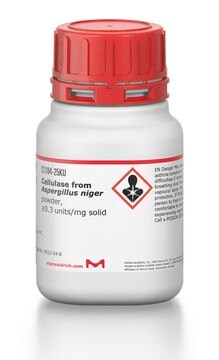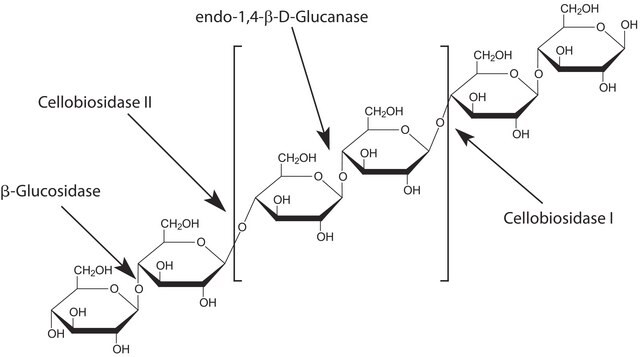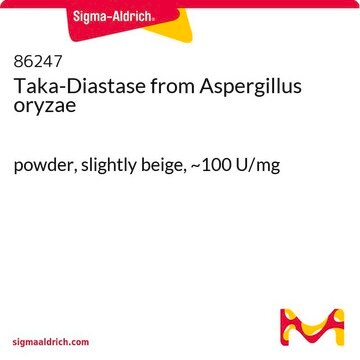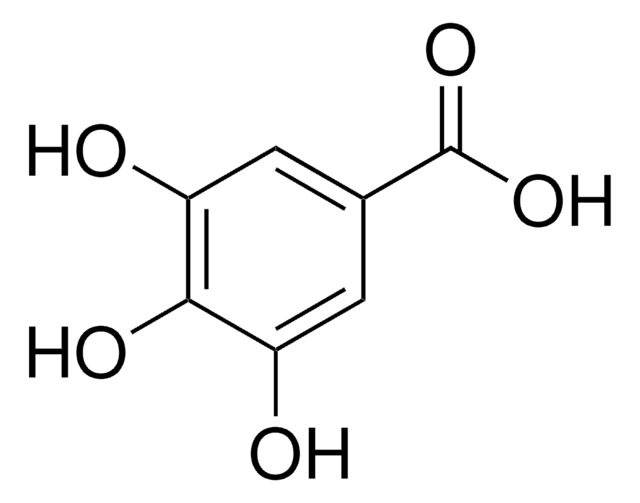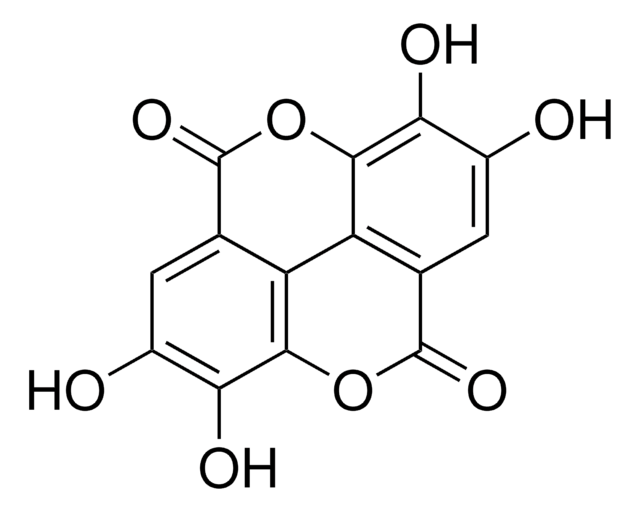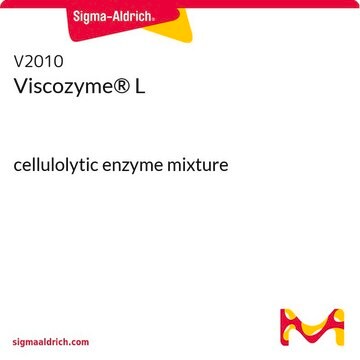추천 제품
생물학적 소스
Aspergillus sp. (A. ficuum)
Quality Level
양식
powder
특이 활성도
≥150 U/g
불순물
25 mM potassium phosphate
250 mM NaCl
50% glycerol
색상
white
저장 온도
2-8°C
일반 설명
Tannase is an enzyme that is produced by several organisms such as plants, bacteria, fungi, and yeast. This enzyme is also found in plant sources such as tannin-rich vegetables, especially in the leaves, fruits, branches, and bark.
애플리케이션
Tannase from Aspergillus ficuum has been used:
- as a standard to determine the tannase activity of bacterial isolates
- to study its effects on the inhibitory activity of tannic acid on biofilm formation
- to obtain Proanthocyanidins (PA) by enzymatic hydrolysis of grape skin and seeds
생화학적/생리학적 작용
Tannase catalyzes the ester bonds located in complex tannins, gallo-tannins, and gallic acid esters, which results in the release of gallic acid. This enzyme can be used as a clarifying agent in the manufacture of beer, tea, wine, and juices and to treat tannin-polluting agricultural waste and industrial effluents.
단위 정의
1 U corresponds to the amount of enzyme which changes the absorbance at 310 nm by 1.0 per minute at pH 4.7 and 30°C (tannic acid as substrate, final volume 3 ml)
신호어
Danger
유해 및 위험 성명서
예방조치 성명서
Hazard Classifications
Resp. Sens. 1
Storage Class Code
11 - Combustible Solids
WGK
WGK 1
Flash Point (°F)
Not applicable
Flash Point (°C)
Not applicable
개인 보호 장비
dust mask type N95 (US), Eyeshields, Faceshields, Gloves
이미 열람한 고객
Arijit Jana et al.
Applied biochemistry and biotechnology, 167(5), 1254-1269 (2012-01-25)
Tannase production by newly isolated Penicillium purpurogenum PAF6 was investigated by 'one variable at a time' (OVAT) approach followed by response surface methodology (RSM). Tannin-rich plant residues were used as supporting solid substrate and sole carbon source and, among them
Jose Valdo Madeira et al.
Bioprocess and biosystems engineering, 35(3), 477-482 (2011-09-13)
The production of enzymes such as tannases and phytases by solid-state fermentation and their use in animal feed have become a subject of great interest. In the present work, Paecilomyces variotii was used to produce tannase and phytase simultaneously. Solid-state
Jose Valdo Madeira et al.
Bioresource technology, 102(15), 7343-7348 (2011-05-27)
In this work, we introduce a biological detoxification method that converts toxic waste from castor beans into animal feed material. This method simultaneously induces the production of tannase and phytase by Paecilomyces variotii; both enzymes have high levels of activity
Bhakti Bajpai et al.
Brazilian journal of microbiology : [publication of the Brazilian Society for Microbiology], 39(4), 708-711 (2008-10-01)
In a new approach to microbial gallic acid production by Aspergillus fischeri MTCC 150, 40gL(-1) of tannic acid was added in two installments during the bioconversion phase of the process (25gL(-1) and 15gL(-1) at 32 and 44h respectively). The optimum
Tadashi Takahashi et al.
Eukaryotic cell, 11(4), 507-517 (2012-01-31)
Loop-out-type recombination is a type of intrachromosomal recombination followed by the excision of a chromosomal region. The detailed mechanism underlying this recombination and the genes involved in loop-out recombination remain unknown. In the present study, we investigated the functions of
자사의 과학자팀은 생명 과학, 재료 과학, 화학 합성, 크로마토그래피, 분석 및 기타 많은 영역을 포함한 모든 과학 분야에 경험이 있습니다..
고객지원팀으로 연락바랍니다.